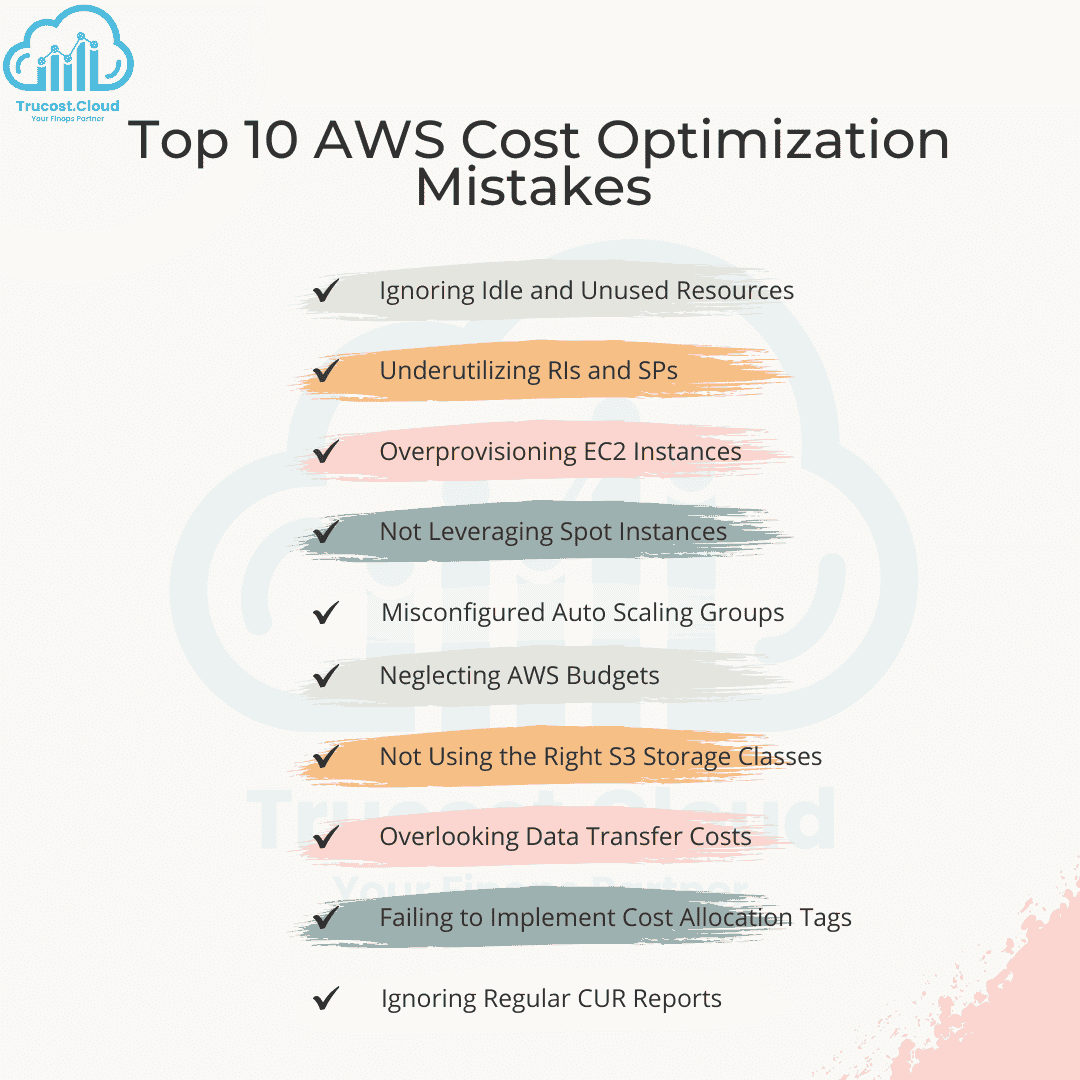
Top 10 AWS Cost Optimization Mistakes and How to Avoid Them
AWS cost optimization:
It is critical for any business leveraging the cloud. While AWS offers incredible flexibility, managing costs can be complex, and many organizations make common mistakes that lead to unnecessary expenses. In this comprehensive guide, we’ll explore the top 10 AWS cost optimization mistakes and how you can avoid them to improve your bottom line. Whether you’re new to AWS or looking to refine your AWS cost management strategy, understanding these pitfalls will help you save significant money and resources.

1. Ignoring Idle and Unused Resources
One of the most frequent AWS cost optimization mistakes is paying for idle or unused resources. This includes instances left running, abandoned EBS volumes, and unused Elastic Load Balancers, all silently draining your budget.
How to Avoid This Mistake:
- Regularly Audit Resources: Use tools like AWS Cost Explorer to identify and terminate unused resources. AWS Trusted Advisor also provides recommendations on idle resources.
- Automate Resource Management: Use AWS Instance Scheduler to automatically start and stop instances based on usage patterns. This is particularly useful for development and testing environments, where resources don’t need to be running 24/7.
Ignoring idle resources can cost you thousands of dollars annually. Regular audits and automation can drastically cut unnecessary spend, making your AWS cost optimization efforts far more effective.
2. Underutilizing Reserved Instances and Savings Plans
Many companies invest in Reserved Instances (RIs) or AWS Savings Plans but fail to maximize their usage due to incorrect forecasts or misaligned reservations. Underutilizing these commitments is a costly oversight in AWS cost management.
How to Avoid This Mistake:
- Analyze Usage Patterns: Before purchasing RIs or Savings Plans, use AWS Cost Explorer to analyze past usage and forecast future needs. Regularly review your reservations to ensure they align with actual consumption.
- Modify and Exchange: AWS allows you to modify or exchange certain RIs to match changing needs. Leverage this flexibility to ensure you’re getting the most out of your investment.
Fully utilizing RIs and Savings Plans can save you up to 72% compared to on-demand pricing. Therefore, aligning reservations with actual usage is crucial for effective AWS cost optimization.
3. Overprovisioning EC2 Instances
Overprovisioning EC2 instances is another common mistake in AWS cost optimization. Selecting larger instance sizes than needed results in paying for unused capacity, which directly impacts your AWS bills.
How to Avoid This Mistake:
- Right-Sizing Analysis: Use AWS Compute Optimizer and AWS Cost Explorer’s Rightsizing Recommendations to identify instances that are over-provisioned. Adjust to a smaller instance type without compromising performance.
- Performance Monitoring: Regularly monitor instance performance using CloudWatch to ensure the chosen instance types meet workload requirements without being oversized.
Optimizing instance sizes not only reduces costs but also enhances your overall cloud efficiency, making it a vital part of any AWS cost management strategy.
4. Not Leveraging Spot Instances
Spot Instances offer up to 90% savings compared to On-Demand prices, yet many businesses avoid them due to perceived complexity or fear of interruptions. This is a significant missed opportunity in AWS cost optimization.
How to Avoid This Mistake:
- Use for Fault-Tolerant Workloads: Integrate Spot Instances for non-critical workloads, such as batch processing, testing, and development. Use AWS Spot Fleets to distribute workloads across multiple instance types and availability zones, reducing the risk of interruptions.
- Spot Instance Automation: Utilize AWS Instance Interruption Notices and automation tools like Spot Fleet and EC2 Auto Scaling to manage Spot Instances efficiently.
Embracing Spot Instances can lead to substantial cost savings without compromising performance, making them a powerful tool in your AWS cost management toolkit.

5. Misconfigured Auto Scaling Groups
Auto Scaling Groups (ASGs) are designed to optimize resource usage and costs by scaling in and out based on demand. However, misconfigured ASGs can lead to over-provisioning, resulting in unnecessary expenses and wasted resources.
How to Avoid This Mistake:
- Set Appropriate Scaling Policies: Define scaling policies based on actual workload patterns. Use target tracking scaling policies with metrics like CPU utilization or custom metrics to ensure accurate scaling decisions.
- Regularly Test and Adjust: Continuously test your scaling configurations to ensure they meet current demands. Adjust scaling thresholds and policies as workload patterns change.
Properly configured ASGs can significantly enhance your AWS cost optimization efforts by ensuring resources are provisioned according to real-time demand.
6. Neglecting AWS Budgets and Billing Alerts
Failing to set up AWS Budgets and billing alerts can result in unexpected charges, especially in environments where usage fluctuates. This oversight is a critical gap in AWS cost management.
How to Avoid This Mistake:
- Set Cost and Usage Budgets: Use AWS Budgets to define custom cost and usage thresholds, and set alerts to notify you when limits are approached or exceeded.
- Enable Billing Alerts: Activate AWS billing alerts to receive notifications about unexpected costs, helping you take corrective actions promptly.
By setting up these controls, you can maintain better visibility over your spending, ensuring proactive AWS cost optimization.

7. Not Using the Right S3 Storage Classes
AWS S3 offers multiple storage classes, each designed for different access patterns and cost structures. Storing all data in the S3 Standard class is an expensive mistake that undermines AWS cost optimization efforts.
How to Avoid This Mistake:
- Analyze Data Access Patterns: Use S3 Storage Lens and Cost Explorer to analyze data access trends. Identify data that is rarely accessed and transition it to cheaper classes like S3 Infrequent Access or Glacier.
- Implement Lifecycle Policies: Set up lifecycle rules to automatically move data between storage classes based on age or access frequency, optimizing storage costs without manual intervention.
Optimizing S3 storage classes ensures that you’re only paying for the level of access your data needs, significantly reducing costs.
8. Overlooking Data Transfer Costs
Data transfer costs, particularly between different AWS regions or from AWS to the internet, can escalate quickly if not monitored. This is a hidden cost that many businesses overlook in their AWS cost management strategy.
How to Avoid This Mistake:
- Keep Data in the Same Region: Minimize inter-region data transfers whenever possible. Consolidate data within the same region to reduce costs.
- Use VPC Endpoints: VPC Endpoints allow you to privately connect to AWS services without needing a public IP address, reducing data transfer fees.
Monitoring and managing data transfer costs can yield significant savings and is a critical aspect of comprehensive AWS cost optimization.
9. Failing to Implement Cost Allocation Tags
Without a proper tagging strategy, tracking expenses across projects, departments, or environments becomes difficult, leading to unmanaged costs. Cost allocation tags are essential for detailed insights into your spending.
How to Avoid This Mistake:
- Establish a Tagging Policy: Implement a clear and consistent tagging policy across your organization. Tags should reflect key cost centers such as projects, teams, or environments.
- Use AWS Cost Explorer: Leverage tagged data in AWS Cost Explorer to create detailed cost allocation reports, providing visibility into how different areas of your organization are driving costs.
Tags empower organizations to manage costs effectively, making them a vital part of any AWS cost optimization approach.
10. Ignoring Regular Cost and Usage Reports
AWS provides extensive reporting tools that help organizations understand and optimize their cloud spend. However, many companies set up their AWS environments and rarely review these reports, missing critical opportunities for AWS cost optimization.
How to Avoid This Mistake:
- Review AWS Cost and Usage Reports (CUR): Schedule regular reviews of your CUR to identify cost trends, anomalies, and areas for improvement.
- Automate Reports and Alerts: Use AWS tools to automate report generation and set up alerts for unexpected cost spikes. AWS Budgets and Cost Anomaly Detection can help you stay on top of your AWS spending.
Regular analysis of cost and usage data helps you make informed decisions, ensuring that your AWS cost management strategy is continuously refined.
Conclusion
Effective AWS cost optimization goes beyond initial setup—it requires continuous monitoring, analysis, and adjustments. Avoiding these common mistakes and implementing the right strategies will empower your organization to manage AWS costs effectively, optimize resources, and drive significant savings.
Effective AWS cost optimization is not a one-time effort but a continuous process that demands regular attention, strategic adjustments, and proactive monitoring. As cloud environments grow and business needs evolve, it’s crucial to stay updated on AWS best practices, leverage new tools, and consistently revisit your optimization strategies. Engaging in ongoing training for your teams, setting clear policies around resource management, and keeping up with AWS updates can make a significant difference.
Remember, each small adjustment, whether it’s tweaking an auto-scaling policy, rightsizing an instance, or automating resource shutdowns, contributes to a larger impact on your overall cloud spend. By avoiding these common mistakes and implementing the right measures, you can transform your AWS environment into a well-oiled, cost-efficient operation that drives value without breaking the bank.
Are you facing challenges with AWS cost management? TruCost.Cloud specializes in FinOps consulting tailored for AWS. Contact us today to learn how we can help you achieve your cost-saving goals!






